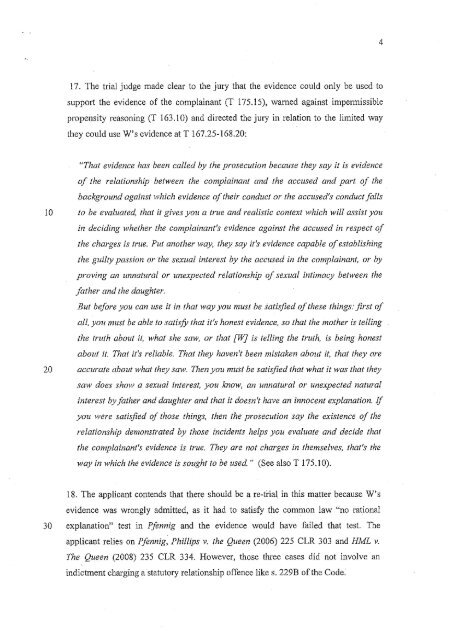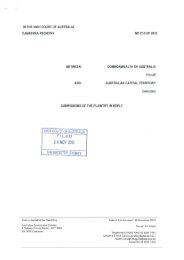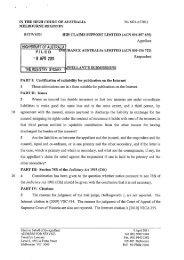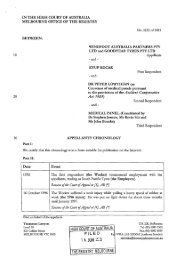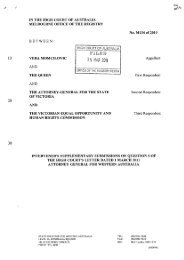Written submissions - High Court of Australia
Written submissions - High Court of Australia
Written submissions - High Court of Australia
You also want an ePaper? Increase the reach of your titles
YUMPU automatically turns print PDFs into web optimized ePapers that Google loves.
4<br />
17. The trial judge made clear to the jury that the evidence could only be used to<br />
support the evidence <strong>of</strong> the complainant (T 175.15), warned against impermissible<br />
propensity reasoning (T 163.10) and directed the jury in relation to the limited way<br />
they could use W's evidence at T 167.25-168.20:<br />
"That evidence has been called by the prosecution because they say it is evidence<br />
<strong>of</strong> the relationship between the complainant and the accused and part <strong>of</strong> the<br />
background against which evidence <strong>of</strong> their conduct or the accused's conduct falls<br />
10 to be evaluated, that it gives you a true and realistic context which will assist you<br />
in deciding whether the complainant's evidence against the accused in respect <strong>of</strong><br />
the charges is true. Put another way, they say it's evidence capable <strong>of</strong> establishing<br />
the guilty passion or the sexual interest by the accused in the complainant, or by<br />
proving an unnatural or unexpected relationship <strong>of</strong> sexual intimacy between the<br />
father and the daughter.<br />
But before you can use it in that way you must be satisfied <strong>of</strong> these things: first <strong>of</strong><br />
all, you must be able to satisfy that it's honest evidence, so that the mother is telling<br />
the truth about it, what she saw, or that [W} is telling the truth, is being honest<br />
about it. That it's reliable. That they haven't been mistaken about it, that they are<br />
20 accurate about what they saw. Then you must be satisfied that what it was that they<br />
saw does show a sexual interest, you know, an unnatural or unexpected natural<br />
interest by father and daughter and that it doesn't have an innocent explanation. If<br />
you were satisfied <strong>of</strong> those things, then the prosecution say the existence <strong>of</strong> the<br />
relationship demonstrated by those incidents helps you evaluate and decide that<br />
the complainant's evidence is true. They are not charges in themselves, that's the<br />
way in which the evidence is sought to be used." (See also T 175.10).<br />
18. The applicant contends that there should be a re-trial in this matter because W's<br />
evidence was wrongly admitted, as it had to satisfy the common law "no rational<br />
30 explanation" test in Pfennig and the evidence would have failed that test. The<br />
applicant relies on Pfennig, Phillips v. the Queen (2006) 225 CLR 303 and HML v.<br />
The Queen (2008) 235 CLR 334. However, those three cases did not involve an<br />
indictment charging a statutory relationship <strong>of</strong>fence like s. 229B <strong>of</strong> the Code:


